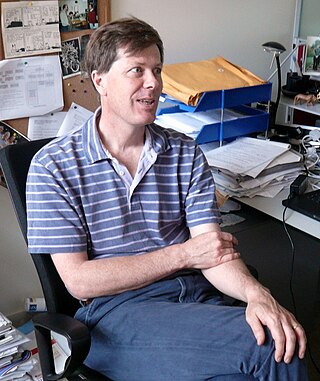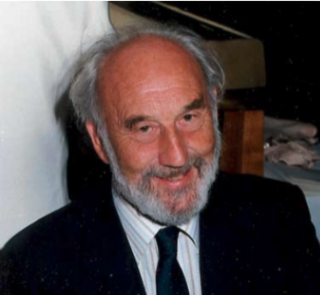
Caenorhabditis elegans is a free-living transparent nematode about 1 mm in length that lives in temperate soil environments. It is the type species of its genus. The name is a blend of the Greek caeno- (recent), rhabditis (rod-like) and Latin elegans (elegant). In 1900, Maupas initially named it Rhabditides elegans. Osche placed it in the subgenus Caenorhabditis in 1952, and in 1955, Dougherty raised Caenorhabditis to the status of genus.

Sydney Brenner was a South African biologist. In 2002, he shared the Nobel Prize in Physiology or Medicine with H. Robert Horvitz and Sir John E. Sulston. Brenner made significant contributions to work on the genetic code, and other areas of molecular biology while working in the Medical Research Council (MRC) Laboratory of Molecular Biology in Cambridge, England. He established the roundworm Caenorhabditis elegans as a model organism for the investigation of developmental biology, and founded the Molecular Sciences Institute in Berkeley, California, United States.

Marco A. Marra is a Distinguished Scientist and Director of Canada's Michael Smith Genome Sciences Centre at the BC Cancer Research Centre and Professor of Medical Genetics at the University of British Columbia (UBC). He also serves as UBC Canada Research Chair in Genome Science for the Canadian Institutes of Health Research and is an inductee in the Canadian Medical Hall of Fame. Marra has been instrumental in bringing genome science to Canada by demonstrating the pivotal role that genomics can play in human health and disease research.

Howard Robert Horvitz ForMemRS NAS AAA&S APS NAM is an American biologist best known for his research on the nematode worm Caenorhabditis elegans, for which he was awarded the 2002 Nobel Prize in Physiology or Medicine, together with Sydney Brenner and John E. Sulston, whose "seminal discoveries concerning the genetic regulation of organ development and programmed cell death" were "important for medical research and have shed new light on the pathogenesis of many diseases".

Sir John Edward Sulston was a British biologist and academic who won the Nobel Prize in Physiology or Medicine for his work on the cell lineage and genome of the worm Caenorhabditis elegans in 2002 with his colleagues Sydney Brenner and Robert Horvitz at the MRC Laboratory of Molecular Biology. He was a leader in human genome research and Chair of the Institute for Science, Ethics and Innovation at the University of Manchester. Sulston was in favour of science in the public interest, such as free public access of scientific information and against the patenting of genes and the privatisation of genetic technologies.

The Wellcome Sanger Institute, previously known as The Sanger Centre and Wellcome Trust Sanger Institute, is a non-profit British genomics and genetics research institute, primarily funded by the Wellcome Trust.
WormBook is an open access, comprehensive collection of original, peer-reviewed chapters covering topics related to the biology of the nematode worm Caenorhabditis elegans . WormBook also includes WormMethods, an up-to-date collection of methods and protocols for C. elegans researchers.

The Medical Research Council (MRC) Laboratory of Molecular Biology (LMB) is a research institute in Cambridge, England, involved in the revolution in molecular biology which occurred in the 1950–60s. Since then it has remained a major medical research laboratory at the forefront of scientific discovery, dedicated to improving the understanding of key biological processes at atomic, molecular and cellular levels using multidisciplinary methods, with a focus on using this knowledge to address key issues in human health.
Caenorhabditis briggsae is a small nematode, closely related to Caenorhabditis elegans. The differences between the two species are subtle. The male tail in C. briggsae has a slightly different morphology from C. elegans. Other differences include changes in vulval precursor competence and the placement of the excretory duct opening. C. briggsae is frequently used to study the differences between it and the more intimately understood C. elegans, especially at the DNA and protein sequence level. Several mutant strains of C. briggsae have also been isolated that facilitate genetic analysis of this organism. C. briggsae, like C. elegans, is a hermaphrodite. The genome sequence for C. briggsae was determined in 2003.

Caenorhabditis is a genus of nematodes which live in bacteria-rich environments like compost piles, decaying dead animals and rotting fruit. The name comes from Greek: caeno- ; rhabditis = rod-like.
Caenorhabditis brenneri is a small nematode, closely related to the model organism Caenorhabditis elegans. Its genome is being sequenced by Washington University in St. Louis Genome Sequencing Center. This species has previously been referred to as C. sp 4 and Caenorhabditis sp. CB5161, but was recently formally described and given its scientific name. This name is in honor of Sydney Brenner, recognizing his pioneering role in starting active research in the field of C. elegans biology and development.
John Graham White is an Emeritus Professor of Anatomy and Molecular Biology at the University of Wisconsin–Madison. His research interests are in the biology of the model organism Caenorhabditis elegans and laser microscopy.

Maynard Victor Olson is an American chemist and molecular biologist. As a professor of genome sciences and medicine at the University of Washington, be became a specialist in the genetics of cystic fibrosis, and one of the founders of the Human Genome Project. During his years at Washington University in St. Louis, he also led efforts to develop yeast artificial chromosomes that allowed for the study of large portions of the human genome.
The nematode worm Caenorhabditis elegans was first studied in the laboratory by Victor Nigon and Ellsworth Dougherty in the 1940s, but came to prominence after being adopted by Sydney Brenner in 1963 as a model organism for the study of developmental biology using genetics. In 1974, Brenner published the results of his first genetic screen, which isolated hundreds of mutants with morphological and functional phenotypes, such as being uncoordinated. In the 1980s, John Sulston and co-workers identified the lineage of all 959 cells in the adult hermaphrodite, the first genes were cloned, and the physical map began to be constructed. In 1998, the worm became the first multi-cellular organism to have its genome sequenced. Notable research using C. elegans includes the discoveries of caspases, RNA interference, and microRNAs. Six scientists have won the Nobel prize for their work on C. elegans.

Richard Michael Durbin is a British computational biologist and Al-Kindi Professor of Genetics at the University of Cambridge. He also serves as an associate faculty member at the Wellcome Sanger Institute where he was previously a senior group leader.
Nematode.net is a publicly available resource dedicated to the study of parasitic nematodes. It stemmed from an Expressed Sequence Tag (EST) project that began at The Genome Institute at Washington University School of Medicine. The site was launched in 2000 to accompany the project “A Genomic Approach to Parasites from the Phylum Nematoda,” funded by the National Institute of Allergy and Infectious Diseases (NIAID). It was created to provide access to the data from this project and as a broader resource for the scientific community studying parasitic nematodes.

Julie Ann Ahringer is an American/British Professor of Genetics and Genomics, Director of the Gurdon Institute and a member of the Department of Genetics at the University of Cambridge. She leads a research lab investigating the control of gene expression.
Eileen Southgate is a British biologist who mapped the complete nervous system of the roundworm Caenorhabditis elegans, together with John White, Nichol Thomson, and Sydney Brenner. The work, done largely by hand-tracing thousands of serial section electron micrographs, was the first complete nervous system map of any animal and it helped establish C. elegans as a model organism. Among other projects carried out as a laboratory assistant at the Medical Research Council Laboratory of Molecular Biology (MRC-LMB), Southgate contributed to work on solving the structure of hemoglobin with Max Perutz and John Kendrew, and investigating the causes of sickle cell disease with Vernon Ingram.

Warwick Llewellyn Nicholas (1926–2010) was an Australian zoologist known as a pioneer in the field of nematology. He was a foundational member of the Australian Society for Parasitology (ASP) and in 1964, he organised the first ASP meeting. He became President of the Society in 1978, before being an elected Fellow from 1979.
Alan Coulson is a British biotechnology pioneer and genome scientist. He is best known for his work on developing DNA sequencing technologies with Frederick Sanger and his contributions to the Caenorhabditis elegans and human genome projects.











